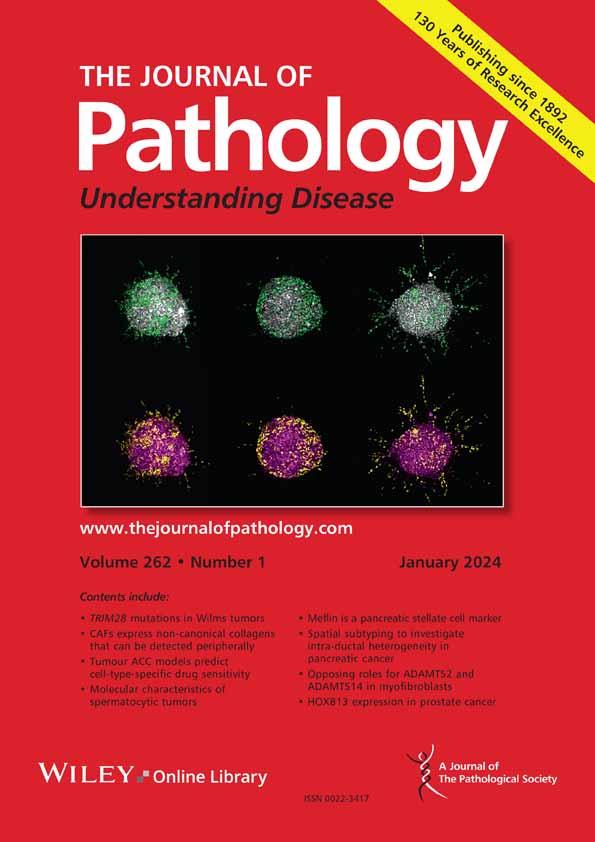Resistance mechanisms and clonal dynamics in mantle cell lymphoma treated with sequential BTKi and venetoclax therapy
IF 5.2
2区 医学
Q1 ONCOLOGY
Tamás László, László Imre Pinczés, Bence Bátai, Luca Varga, Botond Timár, Anita Gulyás, Ilona Tárkányi, Márk Plander, Zsolt Nagy, Péter Rajnics, Miklós Egyed, Zsuzsa Molnár, János Rottek, András Masszi, Péter Tamáska, Róbert Szász, Árpád Illés, Donát Alpár, Ferenc Magyari, Csaba Bödör
下载PDF
{"title":"Resistance mechanisms and clonal dynamics in mantle cell lymphoma treated with sequential BTKi and venetoclax therapy","authors":"Tamás László, László Imre Pinczés, Bence Bátai, Luca Varga, Botond Timár, Anita Gulyás, Ilona Tárkányi, Márk Plander, Zsolt Nagy, Péter Rajnics, Miklós Egyed, Zsuzsa Molnár, János Rottek, András Masszi, Péter Tamáska, Róbert Szász, Árpád Illés, Donát Alpár, Ferenc Magyari, Csaba Bödör","doi":"10.1002/path.6434","DOIUrl":null,"url":null,"abstract":"<p>In recent years, targeted therapies have become the standard of care for refractory/relapsed mantle cell lymphoma (MCL). Although the mutational profile of MCL has been extensively studied, there is a lack of understanding of resistance mechanisms and genetic factors that impact the response to novel treatments. Since patients relapsing on targeted treatment experience poor clinical outcomes, understanding the genetic foundation of resistance mechanisms in MCL is essential. In this study, we aimed to scrutinize the copy number profile and clonal dynamics of double-resistant MCL patients treated sequentially with Bruton's tyrosine kinase inhibitor (BTKi) and venetoclax using low-coverage whole genome sequencing (lcWGS). Samples obtained after systemic therapy showed more copy number alterations (CNAs) (<i>p</i> = 0.039; Wilcoxon) compared to samples collected before treatment initiation. Patients showing early progression on BTKi demonstrated CNAs affecting cytobands encompassing the coding regions of <i>NOTCH1</i>, <i>TRAF2</i>, <i>BIRC2</i>, <i>BIRC3</i>, and <i>ATM</i>. A deletion in chromosome 9p21.3 was identified in two out of three venetoclax-resistant patients. For patient MCL2, progressing on ibrutinib but showing venetoclax resistance, a 9p21.3 deletion was found throughout the disease course, with acquired <i>SMARCA4</i>-del(19)(p13.3–q13.11) and <i>DLC1</i>–del(8)(p23.2–q11.1) observed at relapse, highlighting their role in disease progression and therapy resistance. Using lcWGS, an innovative genome-wide approach, this study revealed novel putative primary and acquired resistance mechanisms in BTKi and venetoclax double-resistant MCL patients. © 2025 The Author(s). <i>The Journal of Pathology</i> published by John Wiley & Sons Ltd on behalf of The Pathological Society of Great Britain and Ireland.</p>","PeriodicalId":232,"journal":{"name":"The Journal of Pathology","volume":"266 4-5","pages":"395-404"},"PeriodicalIF":5.2000,"publicationDate":"2025-05-15","publicationTypes":"Journal Article","fieldsOfStudy":null,"isOpenAccess":false,"openAccessPdf":"https://onlinelibrary.wiley.com/doi/epdf/10.1002/path.6434","citationCount":"0","resultStr":null,"platform":"Semanticscholar","paperid":null,"PeriodicalName":"The Journal of Pathology","FirstCategoryId":"3","ListUrlMain":"https://pathsocjournals.onlinelibrary.wiley.com/doi/10.1002/path.6434","RegionNum":2,"RegionCategory":"医学","ArticlePicture":[],"TitleCN":null,"AbstractTextCN":null,"PMCID":null,"EPubDate":"","PubModel":"","JCR":"Q1","JCRName":"ONCOLOGY","Score":null,"Total":0}
引用次数: 0
引用
批量引用
Abstract
In recent years, targeted therapies have become the standard of care for refractory/relapsed mantle cell lymphoma (MCL). Although the mutational profile of MCL has been extensively studied, there is a lack of understanding of resistance mechanisms and genetic factors that impact the response to novel treatments. Since patients relapsing on targeted treatment experience poor clinical outcomes, understanding the genetic foundation of resistance mechanisms in MCL is essential. In this study, we aimed to scrutinize the copy number profile and clonal dynamics of double-resistant MCL patients treated sequentially with Bruton's tyrosine kinase inhibitor (BTKi) and venetoclax using low-coverage whole genome sequencing (lcWGS). Samples obtained after systemic therapy showed more copy number alterations (CNAs) (p = 0.039; Wilcoxon) compared to samples collected before treatment initiation. Patients showing early progression on BTKi demonstrated CNAs affecting cytobands encompassing the coding regions of NOTCH1 , TRAF2 , BIRC2 , BIRC3 , and ATM . A deletion in chromosome 9p21.3 was identified in two out of three venetoclax-resistant patients. For patient MCL2, progressing on ibrutinib but showing venetoclax resistance, a 9p21.3 deletion was found throughout the disease course, with acquired SMARCA4 -del(19)(p13.3–q13.11) and DLC1 –del(8)(p23.2–q11.1) observed at relapse, highlighting their role in disease progression and therapy resistance. Using lcWGS, an innovative genome-wide approach, this study revealed novel putative primary and acquired resistance mechanisms in BTKi and venetoclax double-resistant MCL patients. © 2025 The Author(s). The Journal of Pathology published by John Wiley & Sons Ltd on behalf of The Pathological Society of Great Britain and Ireland.
连续BTKi和venetoclax治疗套细胞淋巴瘤的耐药机制和克隆动力学。
近年来,靶向治疗已成为难治性/复发性套细胞淋巴瘤(MCL)的标准治疗方法。尽管MCL的突变谱已被广泛研究,但对影响新疗法反应的耐药机制和遗传因素缺乏了解。由于接受靶向治疗后复发的患者临床效果不佳,因此了解MCL耐药机制的遗传基础至关重要。在这项研究中,我们旨在利用低覆盖全基因组测序(lcWGS)研究布鲁顿酪氨酸激酶抑制剂(BTKi)和venetoclax连续治疗双耐药MCL患者的拷贝数谱和克隆动力学。全身治疗后获得的样本显示更多的拷贝数改变(CNAs) (p = 0.039;Wilcoxon)与治疗开始前收集的样本相比。BTKi早期进展的患者表现出CNAs影响NOTCH1、TRAF2、BIRC2、BIRC3和ATM编码区的细胞带。3例venetoclax耐药患者中有2例染色体9p21.3缺失。对于伊鲁替尼治疗进展但显示venetoclax耐药的患者MCL2,在整个病程中发现9p21.3缺失,在复发时观察到获得性SMARCA4-del(19)(p13.3-q13.11)和DLC1-del(8)(p23.2-q11.1),突出了它们在疾病进展和治疗耐药中的作用。使用lcWGS,一种创新的全基因组方法,本研究揭示了BTKi和venetoclax双耐药MCL患者的新的推定原发性和获得性耐药机制。©2025作者。《病理学杂志》由John Wiley & Sons Ltd代表大不列颠和爱尔兰病理学会出版。
本文章由计算机程序翻译,如有差异,请以英文原文为准。
来源期刊
期刊介绍:
The Journal of Pathology aims to serve as a translational bridge between basic biomedical science and clinical medicine with particular emphasis on, but not restricted to, tissue based studies. The main interests of the Journal lie in publishing studies that further our understanding the pathophysiological and pathogenetic mechanisms of human disease.
The Journal of Pathology welcomes investigative studies on human tissues, in vitro and in vivo experimental studies, and investigations based on animal models with a clear relevance to human disease, including transgenic systems.
As well as original research papers, the Journal seeks to provide rapid publication in a variety of other formats, including editorials, review articles, commentaries and perspectives and other features, both contributed and solicited.




 求助内容:
求助内容: 应助结果提醒方式:
应助结果提醒方式:


